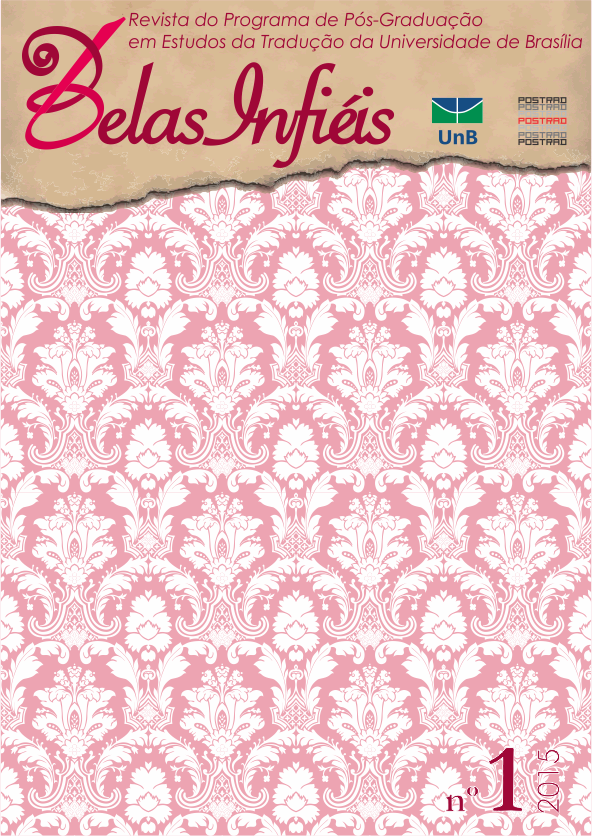UMA BREVE REFLEXÃO HISTORIOGRÁFICA SOBRE A TRADUÇÃO AUTOMÁTICA
DOI:
https://doi.org/10.26512/belasinfieis.v4.n1.2015.11318Palabras clave:
Tradução automática, Historiografia da tradução, Eugene NidaResumen
Este artigo apresenta uma breve reflexão sobre a Tradução Automática (T.A) a partir de uma perspectiva histórica no contexto dos Estudos da Tradução. Em busca de uma maior compreensão sobre alguns dos aspectos mais significativos da área de T.A, consideramos empregar a dicotomia “humano versus automático” para analisar esses dois processos tradutórios distintos. Esta análise consiste em explorar a relação entre o modelo de tradução tripartido de Eugene Nida (tradução humana) e a Abordagem Trifásica dos sistemas de tradução por máquina (tradução automática). Nesse sentido, apresentamos uma síntese da cronologia da Tradução Automática, relacionando-a à evolução da linguística no contexto das gramáticas formais. A partir dos resultados obtidos, propomos uma interpretação das influências e das afinidades observadas entre os processos de tradução humano e automático.
Descargas
Citas
BASSNETT, Susan. Estudos de Tradução. Fundamentos de uma disciplina. Lisboa: Fundação Calouste Gulbenkian, 2003. Tradução de Vivina de Campos Figueiredo; revisão de Ana Maria Chaves.
BERMAN, Antoine. A tradução e a letra ou o albergue do longínquo. Tubarão: Corpiart; Florianópolis, 2013. Tradução de Marie-Hélène C. Torres, Mauri Furlan, Andreia Guerini; revisão de Luana Ferreira de Freitas, Marie-Hélène C. Torres, Mauri Furlan, Orlando Luiz de Araújo.
BOND, F. Toward a Science of Machine Translation. Disponível em http://www.mt-archive.info/TMI-2002-Bond.pdf, 2002.
BOUILLON, Pierrette et CLAS, André. La traductique. Universités francophones. Montréal: Les Presses de l'Université de Montréal, 1993.
BRITO, Eleonora Z. C. D. Em tono da complexidade do campo historiográfico. Revista NetHistória: Para compreender, registrar e formar. Disponível em: <http://www.nethistoria.com.br/secao/ensaios/330/em_torno_da_complexidade_do_campo_historiografico_/>. Acesso em: 26 jul. 2014
CHEVALIER Jean-Claude. Histoires des grammaires. In: Encyclopedia Universalis, CD-ROM Version 7, 2003.
FOCILLON, Henri. Vie des Formes: suivi de l’éloge de la main. Presses de France. Une édition électronique réalisée à partir du livre de Henri Focillon, Vie des formes, suivi de Eloge de la main. Paris: Presses Universitaires de France, 1943.
FUCHS, Catherine. Théories linguistiques. Encyclopedia Universalis. Disponível em: <http://www.universalis.fr/encyclopedie/linguistique-theories/ressources/>. Acesso em 23 jul. 2014
GENTZLER, Edwin. Teorias contemporâneas da tradução. Tradução de Marcos Malvezzi. São Paulo: Madras, 2009.
GUIDÈRE, Mathieu. Introduction à la traductologie. Penser la traduction : hier, aujourd'hui, demain. De Boeck Supérieur s.a. Paris: Bibliothèque nationale, 2010.
HUTCHINS, John. Machine Translation: general overview. In: Mitkov, Ruslan. The Oxford Handbook of Computational Linguistics. Oxford University Press Inc. New York, 2009.
L'HOMME, Marie-Claude. Initiation à la traductique. Brossard : Linguatech éditeur Inc., 2e édition, 2008.
LOFFLER-LAURIAN, Anne-Marie. La Traduction Automatique, Villeneuve d’Ascq (Nord), Presses Universitaires du Septentrion, 1996.
MUNDAY, Jeremy. Introducing Translation Studies: theories and applications. Routledge London and New York; First published 2001.
NIDA, Eugene. (1964). Principles of correspondence. In: Venuti, Lawrence. The Translation Studies Reader. Advisory Editor: Mona Baker. Routledge London and New York. p. 127-140. Fisrt Published 2000.
SANTOS, Cleydstone C. Por uma Linguagem Controlada na Tradução Automática de Resumos Acadêmicos. Tese de Doutorado, Florianópolis: PPGET/UFSC, 2014.
SAUSSURE, Ferdinand de. Cours de linguistique générale. Payot, 1916. [ouvrage posthume, rédigé d'après les notes de ses étudiants]SILVA, Fernando. Análise comparativa dos resultados de Mecanismos de Tradução Automática baseados em regras e estatística. Dissertação de Mestrado, Florianópolis: PPGET/UFSC, 2010.
SCARPA, Federica. La traduction spécialisée. Une approche professionnelle à l'enseignement de la traduction. Traduit et adapté par Marco A. Fiola Les Presses de l'Université d'Ottawa, 2010.
STEINER, George. Depois de Babel: questões de linguagem e tradução. Traduzido da 3ª edição de 1998, por Carlos Alberto Faraco. Curitiba: Editora da UFPR, 2005.
WEININGER, Markus. TM e MT na Tradução Técnica Globalizada: tendências e consequências. UFSC, Cadernos de Tradução, v.2, n.4, 2004.
Descargas
Publicado
Cómo citar
Número
Sección
Licencia
Copyright Statement
Given the public access to this journal, the texts are free to use but requires the recognition of the original authorship and initial publication in this journal to be properly stated.
The journal allows the use of works published for non-commercial purposes, including the right to submit the work to publicly accessible databases. Published contributions are the sole and exclusive responsibility of the author(s).
- When submitting papers to be evaluated by the Belas Infiéis journal, the author(s):
- Declare that the contents of the contributions are original and of their original creation, being entirely responsible for their content if there is an objection by third parties.
- Claim to be aware that they should not commit academic plagiarism.
- Declare that the manuscript has not been published, completely or partially, in Portuguese or another language. If it is a translation it should be submitted to the Translated Articles section.
- Declare that the manuscript is not being evaluated by other journals.
- Declare that the manuscript was not submitted to another journal simultaneously.
- Commit(s) to inform the journal of any kind of error or inaccuracy in their contribution (published, in evaluation or in editing) and to collaborate with the editors to make due corrections of the article (when in evaluation or editing) or erratum/retraction (after publication).
- Declare that there is no conflict of interest regarding the published work.
- Authorize its release if it is accepted for publication without any kind of monetary compensation.
- Agree to assign non-exclusive rights to publication to the magazine, remaining free to make their contribution available in other media as long as the publication of the first version in Belas Infiéis magazine is mentioned. They also authorize Belas Infiéis to assign their texts for reproduction in content indexers, virtual libraries and similar platforms.
- Maintain copyright and grant the journal the right of first publication, the work being licensed under theCreative Commons Attribution License.
- Is/Are allowed and encouraged to publish and distribute their work online after the editorial process, which may increase the impact and citation of the published work.
- Authorize the editorial team to make textual adjustments and to adapt the article to the publication rules, when necessary.



















